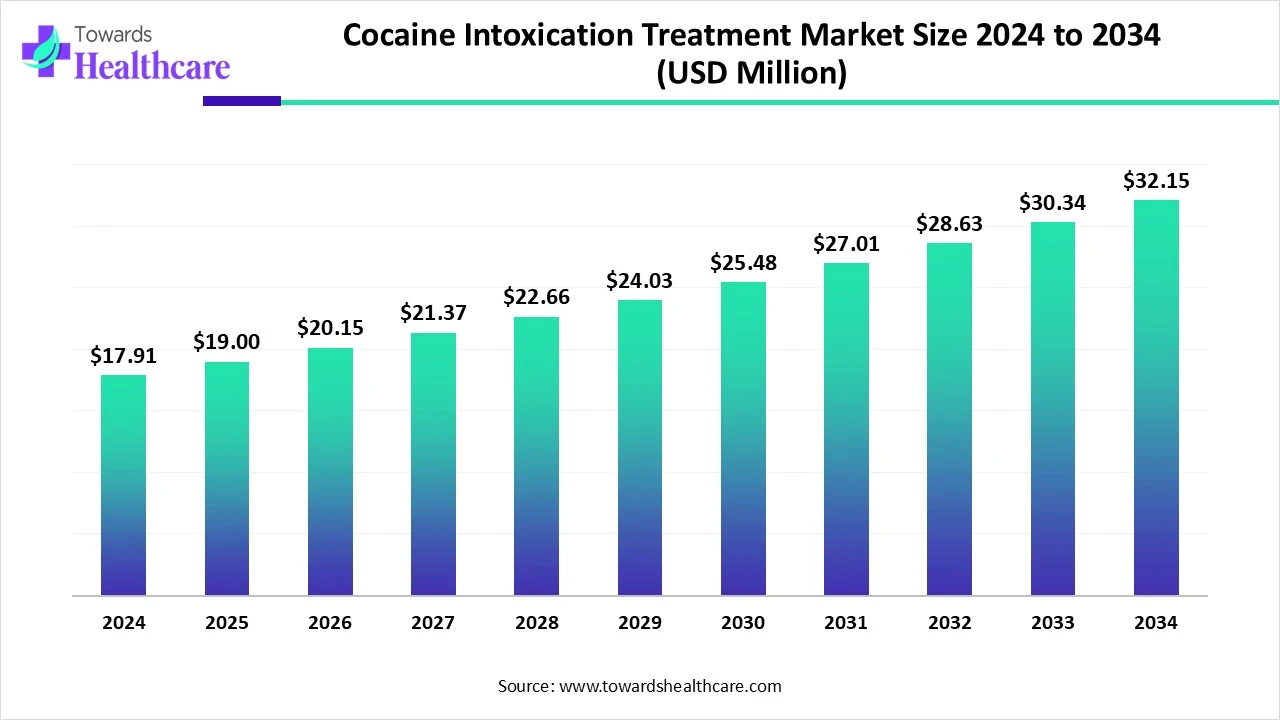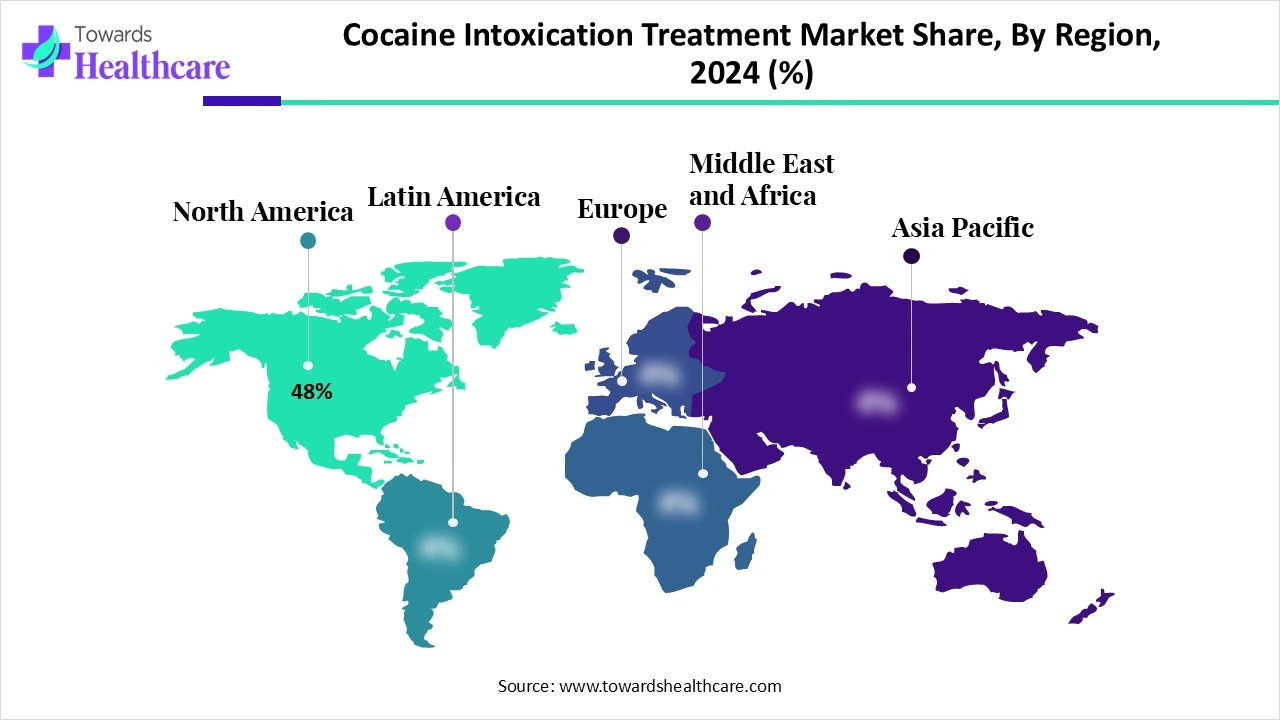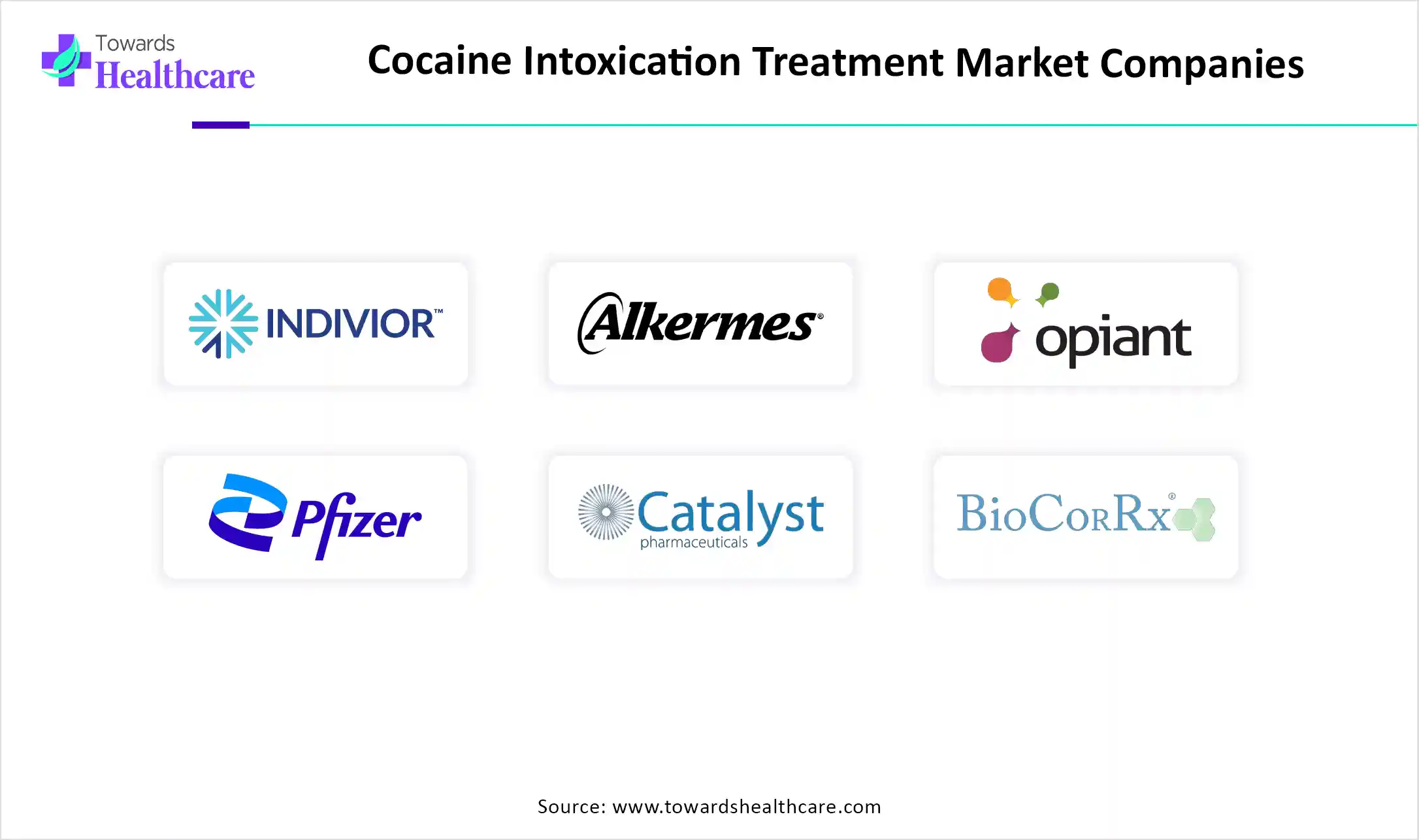November 2025

The global cocaine intoxication treatment market size is calculated at US$ 17.91 in 2024, grew to US$ 19 million in 2025, and is projected to reach around US$ 32.15 million by 2034. The market is expanding at a CAGR of 6.05% between 2025 and 2034.
The strong upward trend in the cocaine intoxication treatment market is being driven by the increasing incidence of stimulant use and the urgent need for therapeutic treatment that is based on evidence. Innovations in treatment and increased public health activism are altering supply and increasing demand in healthcare systems. While operators and investors at the vanguard of innovation and emergency care capacity expansion stand to benefit, areas with inadequate medical infrastructure risk falling behind.

| Metric | Details |
| Market Size in 2025 | USD 19 million |
| Projected Market Size in 2034 | USD 32.15 million |
| CAGR (2025 - 2034) | 6.05% |
| Leading Region | North America share by 48% |
| Market Segmentation | By Treatment Type, By Drug Class, By Severity, By Route of Administration, By End User, By Region |
| Top Key Players | Indivior PLC, Alkermes plc, Opiant Pharmaceuticals (now Indivior), Pfizer Inc., Catalyst Pharmaceuticals, BioCorRx Inc., Cuba’s Center for Molecular Immunology (vaccine candidate), Moderna (preclinical vaccine exploration), Teva Pharmaceuticals, Johnson & Johnson (Janssen Neuroscience division), Camurus AB, Emergent BioSolutions, Tonix Pharmaceuticals (cocaine vaccine candidate – TNX-1300), Braeburn Pharmaceuticals, Zydus Lifesciences Ltd., Dr. Reddy’s Laboratories, Sun Pharmaceutical Industries Ltd., Novartis AG (psychotropic drug support), NIDA (National Institute on Drug Abuse), SAMHSA (U.S. Substance Abuse and Mental Health Services Administration) |
The cocaine intoxication treatment market includes pharmacological, behavioral, and supportive medical interventions for managing acute and chronic toxic effects of cocaine use, including cardiovascular, neurological, and psychiatric symptoms. Cocaine intoxication can lead to arrhythmias, seizures, hyperthermia, agitation, and sudden death, making it a critical emergency condition. Treatment is primarily symptom-focused, as no FDA-approved antidote exists, though clinical trials are ongoing for novel pharmacotherapies. The market is driven by rising cocaine abuse globally, increasing emergency room visits, and public health responses to substance use disorders (SUDs).
The creation of new treatments can be accelerated and precision increased with the use of advanced algorithms in artificial intelligence (AI). Through data analysis, artificial intelligence (AI) improves process accuracy and efficiency while offering solutions for common problems. Furthermore, by customizing treatments to each patient's unique genetic profile and drug reaction, AI-driven precision medicine techniques are transforming the treatment of addiction. This individualized strategy lowers recurrence rates and increases treatment effectiveness.
Rising Cocaine Addiction
At around 0.6% of the global population, there are around 27 million problem drug users, primarily long-term heroin or cocaine addicts. In 2023, there were 23 million cocaine users, according to UN News. Violence increased in countries throughout the supply chain, particularly in Ecuador and the Caribbean, as a result of the product's increased availability and demand.
Lack of FDA-Approved Treatments
One issue facing the cocaine intoxication treatment marketis the lack of FDA-approved medications for cocaine addiction treatment. Although medications are available to treat the symptoms of cocaine consumption, such as sedatives or psychotic episodes, a comprehensive pharmacological solution for treating addiction remains elusive.
How is Telemedicine Useful for the Cocaine Intoxication Treatment Market?
The extensive use of telemedicine is a recent development in the worldwide industry. Telemedicine has become a game-changing method for delivering healthcare remotely as technology develops. Telemedicine enables medical professionals to treat cocaine intoxication by conducting virtual consultations, evaluations, and therapy sessions with patients from the convenience of their homes. Telemedicine is a game-changing trend in addiction medicine because of its ability to improve patient participation and remove geographic constraints, which is transforming the way cocaine intoxication is treated.
By treatment type, the supportive care & symptomatic management segment dominated the cocaine intoxication treatment market in 2024. People with cocaine addiction can get a variety of supportive care options. Patients remain in a calm, encouraging setting that reduces stress and encourages healing throughout detox. Furthermore, a patient's treatment team may prescribe several drugs for symptomatic alleviation of problems as part of a withdrawal management program to keep the patient comfortable throughout their first recuperation.
By treatment type, the pharmacotherapy for cocaine use disorder segment is expected to witness the highest growth rate during the forecast period. The goal of pharmacotherapeutic drugs is to aid the body's inherent healing mechanism. The combination of pharmacotherapy and CM is an important area for future research since scientists are uncertain about how medicine may increase the effectiveness of these treatments.
By drug class, the antihypertensives & beta-blockers segment dominated the cocaine intoxication treatment market in 2024. When individuals exhibit myocardial ischemia and chest discomfort associated with cocaine, beta-blockers may be beneficial, according to a number of recent studies. There are several varieties of antihypertensive medications, and each one lowers blood pressure in a unique way.
By drug class, the CNS modulators & investigational agents segment is estimated to be the fastest-growing during the upcoming timeframe. Drugs known as CNS (Central Nervous System) modulators are a broad class of medications that can alter how the nervous system functions. They are used to treat a variety of neurological and mental health disorders, including cocaine use disorder. The most promising treatments for cocaine dependency appear to be pharmacological ones, such as agonist replacement drugs and GABA medications.
By severity, the severe/acute cocaine toxicity segment held a dominant share of the cocaine intoxication treatment market in 2024. The number of ER visits and hospitalizations for acute intoxication has grown along with the usage of cocaine. Multiple organ failure, mostly of the kidneys and liver, is brought on by acute cocaine intoxication. This dysfunction may be the result of direct injury or, in some cases, muscle damage that manifests as an increased CPK. This suggests that this enzyme should be closely monitored and its potential as a prognostic factor investigated.
By severity, the chronic cocaine use disorder segment is estimated to have the highest CAGR during the upcoming timeframe. Long-term cocaine usage may have a devastating impact on physical health in a variety of ways, not only on mental health. Long-term cocaine addiction dramatically raises the risk of heart disease, stroke, and respiratory failure, according to recent research. As a result, creating an efficient therapy for cocaine intoxication is crucial.
By route of administration, the intravenous segment held the largest share of the cocaine intoxication treatment market in 2024. Intravenous treatment is the most invasive procedure performed by medical professionals. IV treatment is the fastest way to get medications into the body since it bypasses the digestive system and enters the organs directly. It also has an absorption rate of 90–100%.
By route of administration, the intranasal segment is predicted to witness the fastest growth during 2025-2034. Through intranasal administration, drugs can be swiftly and noninvasively transported from the nasal mucosa to the brain, avoiding the blood-brain barrier and treating disorders of the central nervous system. Within minutes, the drug's concentration in the brain may increase due to the quick absorption, which also expedites the drug's onset of effect.
By end-user, the hospitals & emergency departments segment dominated the cocaine intoxication treatment market in 2024. A hospital's emergency department (ED) offers patients who require immediate medical assistance for acute intoxication round-the-clock emergency care. Trained medical professionals work in emergency departments (EDs), evaluating, stabilizing, and treating patients. They frequently use a triage method to prioritize care. Additionally, they are essential in pre-hospital treatment, offering assistance via emergency medical technicians and ambulances.
By end-user, the rehabilitation & detox clinics segment is estimated to grow at the highest rate during the upcoming period. Rehab facilities and detox programs serve distinct purposes in the treatment of drug use disorders. Although they are two different aspects of addiction therapy, detox and rehab are both crucial. Rehab facilitates the development of an action plan for managing addictions, whereas detox aids in the early withdrawal from an addictive drug.

North America dominated the cocaine intoxication treatment market share by 48% in 2024. The market is being driven by the high prevalence of cocaine use disorder in North America, particularly in the U.S., and strong government attempts to provide addiction treatment services. The U.S. is home to several state-of-the-art treatment centers, and its medical professionals offer cutting-edge therapies that are increasingly being adopted throughout the world. North America is expected to remain the market leader due to significant expenditures in addiction treatment programs, advancements in technology, and a focus on public health education.
In 2023, 5.0 million Americans aged 12 and over, or 1.8% of the population, reported using cocaine over the previous 12 months. In 2023, cocaine accounted for nearly one out of every five drug overdose deaths, with American Indian and Alaska Native populations seeing the greatest proportion of cocaine-related overdoses and fatalities. The number of cocaine-related overdose fatalities rose from 1.8 to 8.6 per 100,000 between 2003 and 2023.
In 2023, a little more than one in five Canadians (21%) said they had used illicit drugs at some time in their life. Moreover, over one-third (38%) of those who had ever used illicit substances did so during the previous 12 months. The most police-reported unlawful trafficking incidents in 2023 were cocaine, with 8,203 occurrences during the year, or 20.46 instances per 100,000 people, an increase of 11.7% from the previous year.
Latin America is estimated to host the fastest-growing cocaine intoxication treatment market during the forecast period. Cocaine manufacture and usage are prevalent throughout Latin America, especially in nations like Mexico, Peru, and Colombia. Effective cocaine intoxication therapies are therefore desperately needed in these areas. The region's market has grown as a result of public health initiatives and increased awareness of the risks associated with cocaine consumption. Government financing for addiction treatment initiatives is another factor driving industry expansion.
Approximately 11.4 million Brazilians over the age of 14 have taken cocaine or crack cocaine at some time in their life, according to a recent poll conducted by the Federal University of São Paulo (Unifesp). This equals 6.6% of the nation's total population. At least 2.2 percent of those surveyed, or 3.8 million people, said they had used the drugs in the previous 12 months.
In order to lessen the amount of narcotics that reach the United States, the U.S. and Mexico collaborate on initiatives that help Mexico destroy opium poppies, shut down illegal drug labs, and better track shipments of the raw materials needed to make illegal drugs in Mexico.
Europe is expected to grow significantly in the cocaine intoxication treatment market during the forecast period, fueled by a growing public awareness of substance misuse and robust government funding for addiction treatment. Leading donors include the UK, Germany, and France, for example, whose extensive healthcare systems fund addiction treatment. The European Monitoring Centre for Drugs and Drug Addiction (EMCDDA) reports that cocaine is the second most often used illegal substance in Europe.
The status report from the Federal Criminal Police Office (BKA) states that a record 43 tons of cocaine were captured in Germany in 2023. This exceeded the previous year's amount by more than double. Additionally, Customs claimed that the number of cocaine seizures nearly quadrupled between 2021 and 2023.
In the UK, cocaine consumption is still a major problem that affects people from all areas of life. Concerns over the drug's effects on addiction, health, and society at large are developing as a result of its greater accessibility and increasing purity levels. An estimated 976,000 people utilize it annually.

In April 2025, according to a representative for Harmony Junction Recovery: Alcohol & Drug Rehab, Orange County, the organization is a reputable provider of cocaine rehabilitation in Lake Forest due to its dedication to patient-centered therapy, safety, and comprehensive care. Harmony Junction Recovery provides the tools and assistance required for those seeking successful treatment for cocaine addiction in order to attain long-lasting recovery. (Source - Fox59)
By Treatment Type
By Drug Class
By Severity
By Route of Administration
By End User
By Region
Market insights predict the global optic nerve atrophy treatment industry will increase from USD 2.53 billion ...
According to market projections, the global topical drug delivery market, valued at USD 247.3 billion in 202...
November 2025
November 2025
November 2025
November 2025